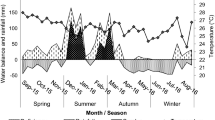Abstract
A study on dry matter production and nutrient cycling in agroforestry systems of mandarin grown in association with N2-fixing Albizia and mixed tree species (non-N2-fixing) was carried out in the Sikkim Himalaya. A site with Albizia was referred asAlbizia-mandarin stand and the other site with mixed tree species as mandarin stand. The stand total biomass, net primary productivity and mandarin fruit production was higher under the influence of Albizia. Agronomic yield of crops remained nearly the same in both the stands. Nitrogen and phosphorus concentrations of different components of Albizia were higher than those of mixed tree species, whereas their back translocation from leaf to branch before abscission was lower inAlbizia. The mandarin-based agroforestry is a highly nutrient-exhaustive system evaluated in terms of nutrient exit through the removal of agronomic yield. This system, under the influence of Albizia, was more productive with faster rates of nutrient cycling. Nutrient use efficiency increased under the influence of Albizia, in contrary to the hypothesis that efficiency should decrease with increasing rate of uptake. The poor nutrient conservation of Albizia, and malleability of nutrient cycling under its influence make it an excellent association which promotes higher availability and faster cycling of nutrients.Albizia should be utilised more extensively in the management of mandarin-based agroforestry systems.
Similar content being viewed by others
References
Ae N, Arihara J, Okada K, Yoshihara T and Johansen C (1990) Phosphorus uptake by pigeon pea and its role in cropping systems of the Indian subcontinent. Science 248: 477–480
Anderson JM and Ingram JSI (1989) Tropical Soil Biology and Fertility: A Handbook of Methods. CAB International, UK
Anonymous (1981) Agriculture Census of Sikkim, Government of Sikkim, India
Binkley D (1983) Interaction of site fertility and red alder on ecosystem production in douglasfir plantations. Forest Ecology and Management 5: 215–227
Binkley D (1992) Ecology of mixtures of nitrogen-fixing and non-nitrogen-fixing tree species. In: Canell MGR, Malcolm DC and Robertson PA (eds) The Ecology of Mixed Species Stands of Trees, pp 99–123. Blackwell Scientific Publications, Oxford, UK
Binkley D, Lousier JD and Cromack Jr K (1984) Ecosystem effects of Sitka alder in a Douglasfir plantation. Forest Science 30: 26–35
Binkley D, Sollins P, Bell R, Sachs D and Myrold D (1992) Biogeochemistry of adjacent conifer and alder/conifer stands. Ecology 73: 2022–2033
Bloom A, Chapin III FS and Mooney H (1985) Resource limitation in plants—an economic analogy. Annual Review of Ecology and Systematics 16: 363–392
Bocock KL, Gilbert OJ, Capstick CK, Turner DC, Ward JS and Woodman MJ (1960) Changes in leaf litter when placed on the surface of soil with constrasting humus types. Journal of Soil Science 11: 1–9
DeBell DS, Whitesell CD and Schubert TH (1989) Using N2-fixing Albizia to increase growth of Eucalyptus plantations in Hawaii. Forest Science 35: 64–75
Gillespie AR and Pope PE (1989) Alfalfa N2-fixation enhances the phosphorus uptake of walnut in interplantings. Plant and Soil 113: 291–293
Ho I (1979) Acid phosphatase activity in forest soil. Forest Science 25: 567–568
Horwitz W, ed (1980) Methods of Analysis. Association of Official Analytical Chemists, Benjamin Franklin Station, Washington, DC, USA
Jackson ML (1973) Soil Chemical Analysis, Prentice-Hall of India Pvt Ltd, New Delhi, India
Malcolm DC, Hooker J and Wheeler CT (1985) Frankia symbioses as a source of nitrogen in forestry: a case study of symbiotic nitrogen-fixation in a mixed Alnus-Picea plantation in Scotland. Proceedings of the Royal Society of Edinburgh 85B: 263–282
Melillo JM and Gosz J (1983) Interactions of biogeochemical cycles in forest ecosystems. In: Bolin B and Cook R (eds) The Major Biogeochemical Cycles and Their Interactions, pp 177–221. Wiley, New York
Ruark GA, Martin GL and Bockheim JG (1987) Composition of constant and varibale allometric ratios for estimating Populus tremuloides biomass. Forest Science 33: 294–300
Sharma E (1993) Nutrient dynamics in Himalayan alder plantations. Annals of Botany 72: 329–336
Sharma E and Ambasht RS (1987) Litterfall, decomposition and nutrient release in an age sequence of Alnus nepalensis plantation stands in the eastern Himalayas. Journal of Ecology 75: 997–1010
Sharma E, Sundriyal RC, Rai SC, Bhatt YK, Rai LK, Sharma R and Rai YK (1992) Integrated Watershed Management: A Case Study in Sikkim Himalaya. Gyanodaya Prakashan, Nainital, India
Sharma R, Sharma E and Purohit AN (1994) Dry matter production and nutrient cycling in agroforestry systems of cardamom grown underAlnus and natural forest. Agroforestry Systems 27: 293–306
Sprugel DG (1984) Density, biomass, productivity and nutrient cycling changes during stand development in wave-regenerated balsam fir forests. Ecological Monographs 54: 165–186
Sundriyal RC, Rai SC, Sharma E and Rai YK (1994a) Hill agroforestry system in south Sikkim, India. Agroforestry Systems 26: 215–235
Sundriyal RC, Rai SC and Sharma E (1994b) Watershed-based participatory development strategy in Sikkim. In: Lama MP (ed) Sikkim: Society, Polity, Economy and Environment, pp 178–194. Indus Publication House, Delhi
Sundriyal RC, Sharma E, Rai LK and Rai SC (1994c) Tree structure, regeneration and woody biomass removal in a subtropical forest of Mamlay watershed in the Sikkim Himalaya. Vegetatio 113: 53–63
Tarrant RF, Lu KC, Bollen W and Franklin JF (1969) Nitrogen enrichment of two forest ecosystems by red alder. United States Forest Service Research Paper PNW-76
Whittaker RH and Marks PL (1975) Methods of assessing terrestrial productivity. In: Lieth H and Whittaker RH (eds) Primary Productivity of the Biosphere, pp 55–118. Springer-Verlag, New York
Whittaker RH and Woodwell GM (1968) Dimension and production relations of trees and shrubs in the Brookhaven forest, New York. Journal of Ecology 56: 1–25
Author information
Authors and Affiliations
Rights and permissions
About this article
Cite this article
Sharma, R., Sharma, E. & Purohit, A.N. Dry matter production and nutrient cycling in agroforestry systems of mandarin grown in association with Albizia and mixed tree species. Agroforest Syst 29, 165–179 (1995). https://doi.org/10.1007/BF00704884
Issue Date:
DOI: https://doi.org/10.1007/BF00704884




